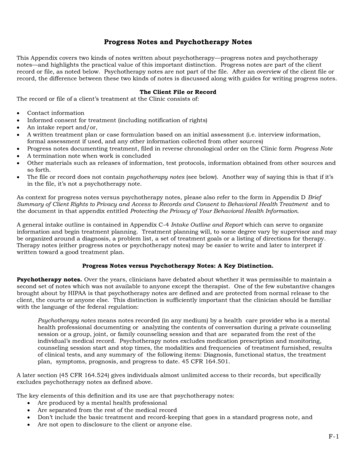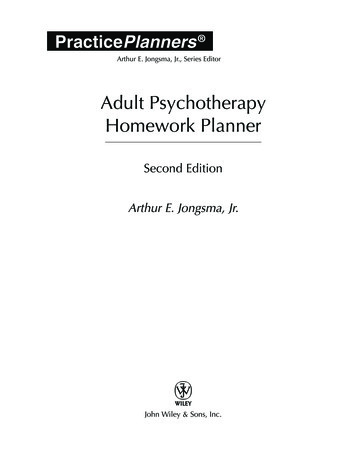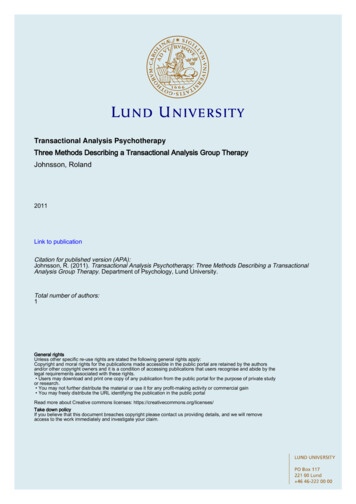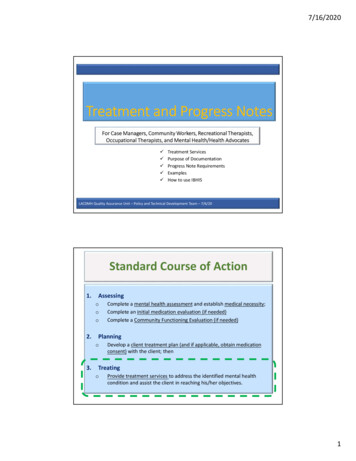
Transcription
Progress Notes and Psychotherapy NotesThis Appendix covers two kinds of notes written about psychotherapy—progress notes and psychotherapynotes—and highlights the practical value of this important distinction. Progress notes are part of the clientrecord or file, as noted below. Psychotherapy notes are not part of the file. After an overview of the client file orrecord, the difference between these two kinds of notes is discussed along with guides for writing progress notes.The Client File or RecordThe record or file of a client’s treatment at the Clinic consists of: Contact informationInformed consent for treatment (including notification of rights)An intake report and/or,A written treatment plan or case formulation based on an initial assessment (i.e. interview information,formal assessment if used, and any other information collected from other sources)Progress notes documenting treatment, filed in reverse chronological order on the Clinic form Progress NoteA termination note when work is concludedOther materials such as releases of information, test protocols, information obtained from other sources andso forth.The file or record does not contain psychotherapy notes (see below). Another way of saying this is that if it’sin the file, it’s not a psychotherapy note.As context for progress notes versus psychotherapy notes, please also refer to the form in Appendix D BriefSummary of Client Rights to Privacy and Access to Records and Consent to Behavioral Health Treatment and tothe document in that appendix entitled Protecting the Privacy of Your Behavioral Health Information.A general intake outline is contained in Appendix C-4 Intake Outline and Report which can serve to organizeinformation and begin treatment planning. Treatment planning will, to some degree vary by supervisor and maybe organized around a diagnosis, a problem list, a set of treatment goals or a listing of directions for therapy.Therapy notes (either progress notes or psychotherapy notes) may be easier to write and later to interpret ifwritten toward a good treatment plan.Progress Notes versus Psychotherapy Notes: A Key Distinction.Psychotherapy notes. Over the years, clinicians have debated about whether it was permissible to maintain asecond set of notes which was not available to anyone except the therapist. One of the few substantive changesbrought about by HIPAA is that psychotherapy notes are defined and are protected from normal release to theclient, the courts or anyone else. This distinction is sufficiently important that the clinician should be familiarwith the language of the federal regulation:Psychotherapy notes means notes recorded (in any medium) by a health care provider who is a mentalhealth professional documenting or analyzing the contents of conversation during a private counselingsession or a group, joint, or family counseling session and that are separated from the rest of theindividual’s medical record. Psychotherapy notes excludes medication prescription and monitoring,counseling session start and stop times, the modalities and frequencies of treatment furnished, resultsof clinical tests, and any summary of the following items: Diagnosis, functional status, the treatmentplan, symptoms, prognosis, and progress to date. 45 CFR 164.501.A later section (45 CFR 164.524) gives individuals almost unlimited access to their records, but specificallyexcludes psychotherapy notes as defined above.The key elements of this definition and its use are that psychotherapy notes: Are produced by a mental health professional Are separated from the rest of the medical record Don’t include the basic treatment and record-keeping that goes in a standard progress note, and Are not open to disclosure to the client or anyone else.F-1
Progress notes. Progress notes, then, are notes that are part of the regular file maintained in the Clinic.Because many of the functions of notes for the purposes of the treating clinician can be accomplished throughpsychotherapy notes, progress notes content can be kept to minimum. The following kinds of information go ina progress note (further guidelines and examples appear below). counseling session start and stop times, medication prescription and monitoring the modalities and frequencies of treatment furnished, results of clinical tests, and any summary of the following items:o Diagnosis,o functional status,o symptoms,o prognosis, ando progress to date.Who Is The Audience?In any writing project, the first and most important question is “who is the audience?” Throughout the writingprocess, one must step back occasionally and hear what is written using the ears of the potential audience(s).Often, as with the notes we’ll be discussing here, there will be multiple audiences and you must keep each ofthem in mind while writing. Here is a listing, intended to be in order of likelihood, of those who will see and useprogress notes: You, the therapist, will look back at the notes as needed in the course of treatment. The client or patient may want to look at the notes and the contents of the file and has this right underNew Mexico guidelines and HIPAA regulations Another therapist who picks up the case at the Clinic or in another setting (with appropriate release ofinformation). An evaluator for another agency may review therapy notes, again with the client’s permission An attorney representing your client or (perhaps more importantly) an opposing attorney in a legalproceeding (this may be by release of information or through a “hidden permission” in a law suit claimingdamages for “pain and suffering”—see the Clinic’s document Protecting the Privacy of Your BehavioralHealth Information).These various potential readers of your notes create different concerns and expectations for the contents of yournotes. What will be most useful to you in the future may very well not be what you would want your client toread and a note that works for you and your client may not be something you’d want in the hands of a attorneyhostile to your client’s interests. You won’t know as you write which audience will see your notes, but need tokeep in mind that you are writing for these different readers.This is not, in practice a difficult task. First, keep in mind that your task in a progress note is to documentthat reasonable work occurred toward the goal of helping the client with her or his issues. Your note can bebrief; to the extent that you can relate that day’s work to treatment issues and methods you’ve defined previouslyin a treatment plan, the easier your documentation will be. Keep track of significant events—changes inmedications, life events, names of important people that come up—that you will want to be able to easilyreference in the future. As noted in the formats described below, include brief assessments of the client’s statusand progress as appropriate and remind yourself of plans you have for future sessions (homework assignments,topics to follow up on).Leave longer thoughts, queries and reflections for your psychotherapy notes. The advantage that psychotherapynotes give us is that you can record any hypotheses, personal reactions, doubts, possible interpretations,supervisory recommendations, etc. in a form that will be maximally useful for you.Where Are The Two Kinds Of Notes Kept?In general, progress notes will be written immediately following a session and will be kept in reversechronological order in the client’s file locked in the appropriate drawer in the Clinic. The client’s file may beremoved only for purposes of writing and reviewing notes and replaced when you are finished. Supervisors willF-2
come to the Clinic to review files periodically (at least each semester). If an occasion arises in which you want toremove the file from the Clinic, you need permission of the Clinic Director and need to put a check-out cardwhere the file was so that staff know it is out. If you are in possession of a file, you are responsible formaintaining its confidentiality—keep it in your possession or keep it in a secure place.Psychotherapy notes must be kept separate from the main file. That could be in a different locked drawer at theClinic (but never in the top drawer where active files are kept). It is likely that these are the notes you’ll wantwith you for supervision and preparation for sessions, so you may keep them in your possession. If so, you mustassure that confidential information is protected by securing these files in your home or office. Each clinicianshould develop habits and methods of protecting confidential information, for instance, psychotherapy notes andtesting files that you may want in your possession and care outside the Clinic building.A note regarding assessment files is in order at this point. You may be keeping assessment materials with youfor scoring and writing outside the Clinic. The safest way to preserve confidentiality and secure the file is to keepname identification out of the file until you finalize it in a report. Then secure the original file and all materialsat the Clinic.Styles Of Progress NotesThe following are some suggestions for the content of progress notes:1. Use the Clinic’s standard Progress Note form (Appendix F-2) to provide the basic information about whowas seen when by whom, for how long and for what purpose. Payment is recorded on this form as well inaddition to the receipts filled out for the client and the Clinic.2. The note may be brief but should include a description of the major events or topics discussed, specificinterventions used, your observations and assessment of the client’s status, and any plans you may havefor the future.3. It is not necessary that these notes be extensive. In fact, in future practice when time is of the essence,brevity and capturing the essence of the treatment in a session will be necessary. Two examples ofstructured systems for progress note writing are listed briefly below with references to more completedescriptions.Compared to psychotherapy notes. By their nature, psychotherapy notes can be in any form that is useful toyou and need not be readable by others (e.g. use of your own personal shorthand is acceptable). Think ofpsychotherapy notes as a form of self-consultation and preparation for supervision. It is here that you may feelfree to detail what happened in a session in order, put your thoughts and feelings about what was going on, listhunches and hypotheses to explore further, and write questions to bring up with your supervisor. You may alsowant to jot notes from your supervisory session that you want to include in your thinking for future sessions.D(R)AP format for progress notes. In hospital settings, the most common guideline for notes is the SOAPformat (Subjective, Objective, Assessment, Plan) described briefly below. Many practitioners have found theSOAP format awkward or forced for recording progress in psychotherapy. The preferred format for notes at theClinic uses the acronym DAP (Description, Assessment and Plan). Baird (2002) suggests a similar format andhis thoughts on clinical documentation are useful. In a typical therapy session, a client may bring up two orthree therapy-significant events or issues or describe the activity of carrying out a homework assignement. Eachmay be briefly documented in the DAP format.Description, as Baird elaborates, provides information as to who was involved, where, and when a significantevent occurred. It could also be a description of an issue of personal importance discussed by the client andhow they experienced the event. A description could also be the way a client carried out an assignment and thedifficulties or success they experienced. Baird includes a separate section (R for Response) for what the cliniciandoes in response to the client’s issue. We recommend that clinician behavior be woven into description.Response (per Baird) is what you did after listening and observing and reflecting on what the client brought tothe session. This may be an interpretation offered, a clarification, information given, a homework assignment, achallenge to narrow thinking about an issue, formal problem solving around the event, empathetic/supportivebehavior on your part, functional analysis of a situation, a normalizing comment, or whatever is appropriatefrom the therapeutic conceptualization you are using. If the situation is a serious one involving detailedF-3
assessment of danger or legal issues, you would document what you did in whatever detail is necessary to showthat you attended to the issues involved.Assessment is your understanding of what the event means if you know. Baird recommends thinking about howthe event or behavior relates to precipitating factors, to previous behavior, to other events in the client’s life, tothe treatment plan. The important part of this aspect of your thinking and writing is your reflection on theevents in the client’s life in terms of treatment. Assessment may also record your observations about the client’sphysical or emotional state and such factors as severity of symptoms, riskiness of behavior, dangerousness,suicidality and so forth.Treatment Plan is your plan for future treatment. Baird notes that this may be as brief as “Scheduled for nextWed”. If you give homework assignments or want to note topics to follow up on or actions to take before the nextsession, they can be entered here as reminders.Examples of DAP notes are given on the Clinic website.SOAP format notes. SOAP is an acronym for Subjective-Objective-Assessment-Plan and is a part of ProblemOriented medical records developed by L. L. Weed (see Cameron and Turtle-song, 2002 on the Clinic webpage fora fuller description). This method was developed in the medical setting to standardize entries in the patient file(e.g. S(ubjective): “Patient complained of ”; O(bjective): Blood pressure, lab results, results of physicalexamination; A(ssessment): clinical diagnosis of symptoms; P(lan): presc
In hospital settings, the most common guideline for notes is the SOAP format (Subjective, Objective, Assessment, Plan) described briefly below. Many practitioners have found the SOAP format awkward or forced for recording progress in psychotherapy. The preferred format for notes at the Clinic uses the acronym DAP (Description, Assessment and Plan). Baird (2002) suggests a similar format andFile Size: 860KBPage Count: 23










